January 20, 2017 / Guangdong Institute of Microbiology and Center for Disease Control and Prevention of Guangdong Province / Journal of Ethnopharmacology
Text/ Wu Tingyao
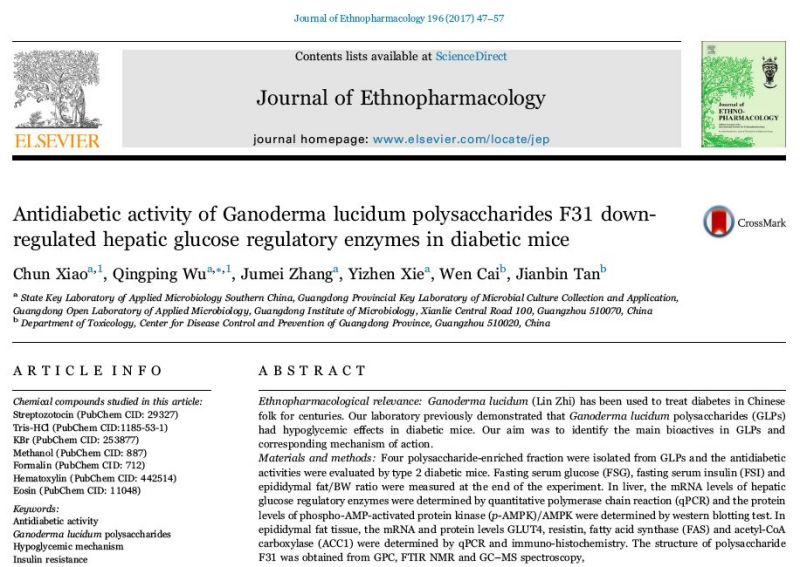
It has long been a recognized fact that Ganoderma lucidum polysaccharides can help treat diabetes, but how it works is a topic that scientists want to know more about.
As early as 2012, Guangdong Institute of Microbiology and Center for Disease Control and Prevention of Guangdong Province jointly issued a report stating that the high molecular weight polysaccharides (GLPs) extracted from the hot water extract of Ganoderma lucidum fruiting bodies have a good hypoglycemic effect for type 2 diabetes (T2D).
Now, they have further isolated four polysaccharides from GLPs, and took the more active F31 (molecular weight of about 15.9 kDa, containing 15.1% protein) for in-depth study, and found that it can not only regulate blood glucose through multiple pathways but also protect the liver.
Lingzhi polysaccharides can reduce hyperglycemia.
In a 6-week animal experiment, it was found that type 2 diabetic mice (Ganoderma lucidum group-high dose) fed with 50 mg/kg Ganoderma lucidum polysaccharides F31 every day had consistently lower fasting blood glucose levels than untreated diabetic mice (control group), and there were significant differences.
In contrast, the diabetic mice (Ganoderma lucidum group-low dose) that also ate Ganoderma lucidum polysaccharides F31 daily but at a dose of only 25 mg/kg had a less obvious drop in blood glucose. This shows that the Ganoderma lucidum polysaccharides have the effect of regulating blood glucose, but the effect will be affected by the dosage (Figure 1).
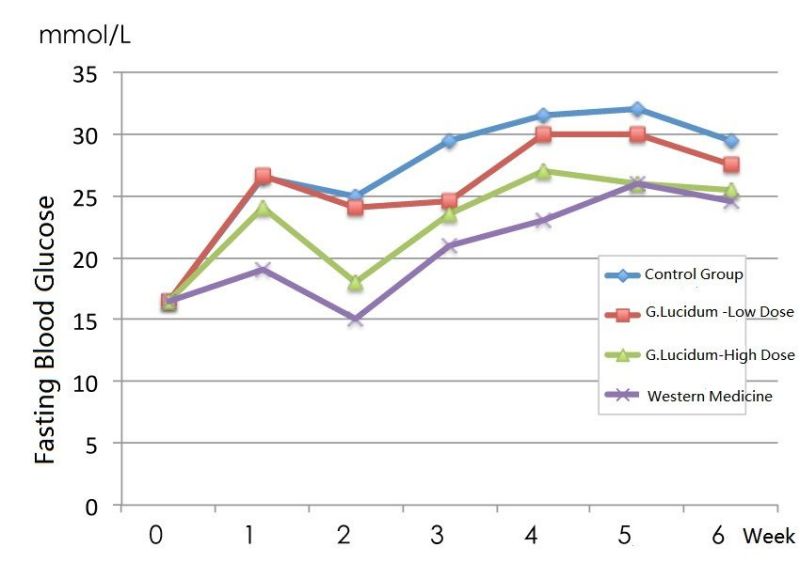
Figure 1 The effect of Ganoderma lucidum on fasting blood glucose levels in diabetic mice
[Explanation] The hypoglycemic drug used in the “Western Medicine Group” is metformin (Loditon), which is taken orally at 50 mg/kg daily. The blood glucose unit in the figure is mmol/L. Divide the blood glucose value by 0.0555 to get the mg/dL. The normal fasting blood glucose level should be below 5.6 mmol/L (approximately 100 mg/dL), more than 7 mmol/L (126 mg/dL) is diabetes. (Drawn by/Wu Tingyao, data source/J Ethnopharmacol. 2017; 196:47-57.)
Reishi mushroom polysaccharides reduce liver damage caused by diabetes.
It can be found from Figure 1 that although Ganoderma lucidum polysaccharides F31 can regulate blood glucose, its effect is slightly inferior to that of western medicine, and it cannot restore blood glucose to normal. Nevertheless, Ganoderma lucidum polysaccharides have begun to play a role in protecting the liver.
It can be seen from Figure 2, during the experiment, the structure and morphology of liver tissue of diabetic mice protected by Ganoderma lucidum polysaccharides F31 (50 mg/kg) were similar to that of normal mice, and there was less inflammation. In contrast, the liver tissues of diabetic mice that did not receive any treatment were significantly damaged, and the conditions of inflammation and necrosis were also more serious.
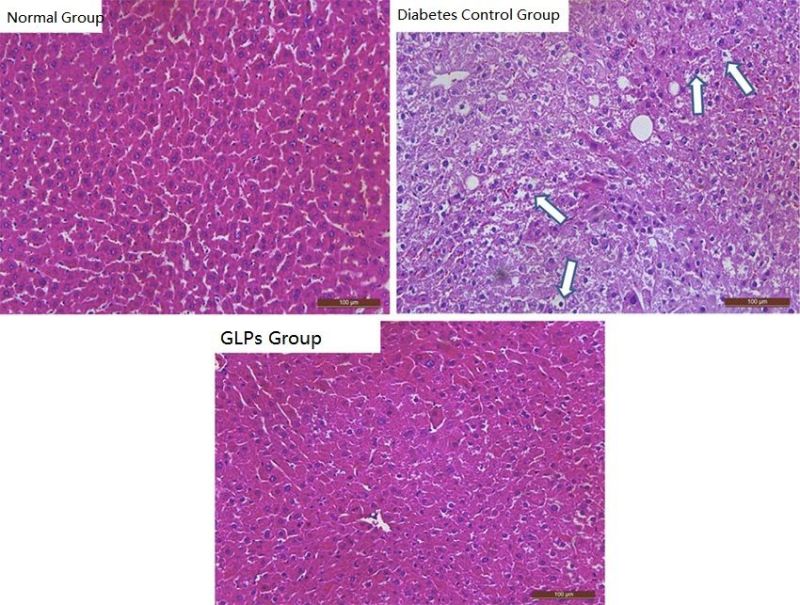
Figure 2 Hepatoprotective effect of Ganoderma lucidum polysaccharides on diabetic mice
[Explanation] The white arrow points to an inflamed or necrotic lesion. (Source/J Ethnopharmacol. 2017; 196:47-57.)
Pathogenesis of type 2 diabetes
Many studies in the past explained the mechanism of Ganoderma lucidum polysaccharides regulating blood glucose from the perspective of “protecting pancreatic islet cells and enhancing insulin secretion.” This study suggests that Ganoderma lucidum polysaccharides can also improve hyperglycemia in other ways.
Before going further, we must first know a few keys to the formation of type 2 diabetes. After a person with normal metabolic function eats, his pancreatic islet cells will secrete insulin, which stimulates muscle cells and fat cells to produce “glucose transporter (GLUT4)” on the cell surface to “transport” the glucose in the blood into the cells.
Because glucose cannot cross the cell membrane directly, it cannot enter cells without the help of GLUT4. The crux of type 2 diabetes is that cells are not sensitive to insulin (insulin resistance). Even if insulin is secreted frequently, it still cannot produce enough GLUT4 on the cell surface.
This situation is more likely to occur in obese people, because fat synthesizes a peptide hormone called “resistin”, which causes insulin resistance in fat cells.
Since glucose is the cell’s energy source, when cells have been lacking glucose, in addition to making people want to eat more, it will also encourage the liver to produce more glucose.
There are two ways for the liver to produce glucose: one is to decompose glycogen, that is, to use the glucose originally stored in the liver; the other is to regenerate glycogen, that is, to convert non-carbohydrate raw materials such as protein and fat into glucose.
These two effects in patients with type 2 diabetes are more vigorous than those in ordinary people. When the utilization rate of glucose by tissue cells decreases while the amount of glucose production continues to rise, it is naturally difficult for blood glucose to fall.
Ganoderma lucidum polysaccharides reduce the amount of glucose produced by the liver and improve the utilization rate of glucose by cells.
Ganoderma lucidum polysaccharides F31 seem to be able to solve the above problems. After the end of the animal experiment, the researchers took out the mouse liver and epididymal fat (as an indicator of body fat), analyzed and compared them, and found that F31 has the following mechanism of action (Figure 3):
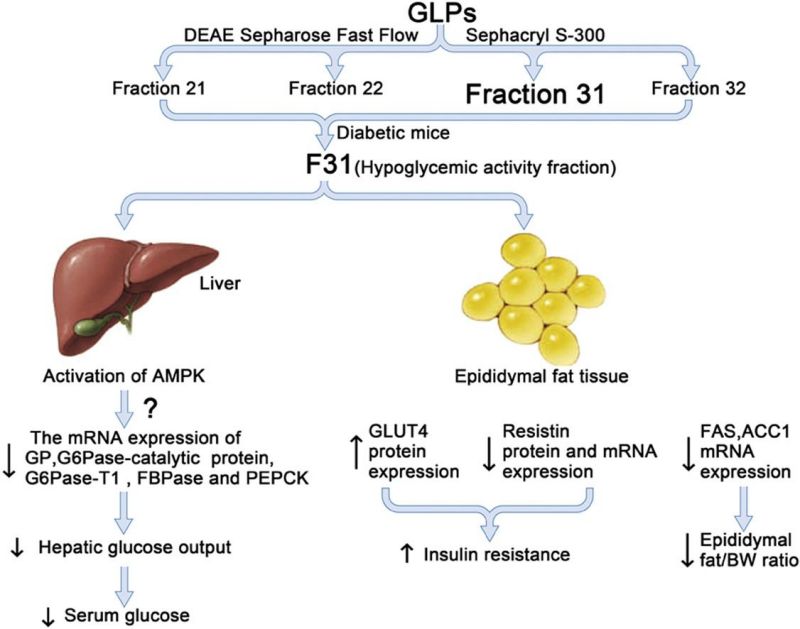
1.Activate AMPK protein kinase in the liver, reduce the gene expression of several enzymes involved in glycogenolysis or gluconeogenesis in the liver, reduce glucose production, and control blood glucose from the source.
2. Increase the number of GLUT4 on adipocytes and inhibit the secretion of resistin from adipocytes (making these two variables very close to the condition of normal mice), thereby improving the sensitivity of adipocytes to insulin and increasing the utilization of glucose.
3. Significantly reduce the gene expression of key enzymes involved in fat synthesis in adipose tissue, thereby reducing the proportion of fat in the body weight and reducing the factors related to insulin resistance.
It can be seen that Ganoderma lucidum polysaccharides can regulate blood glucose through at least three pathways, and these pathways have nothing to do with “stimulating insulin secretion”, providing more possibilities for the improvement of diabetes.
Figure 3 The mechanism of Ganoderma lucidum polysaccharides in regulating blood glucose
[Explanation] The epididymis is a coil-like thin seminiferous tube that is close to the top of the testicle, connecting the vas deferens and the testicles. Since the fat around the epididymis is positively correlated with the total fat of the whole body (especially visceral fat), it often becomes the observation index of the experiment. As for how to reduce GP and other enzymes after Ganoderma lucidum polysaccharides activate AMPK, it needs to be further clarified, so the relationship between the two is indicated by “?” in the figure. (Source/J Ethnopharmacol. 2017; 196:47-57.)
The single kind of Ganoderma lucidum polysaccharides is not necessarily better.
The above-mentioned research results give us a better understanding of “how Ganoderma lucidum polysaccharides are beneficial to type 2 diabetes”. It also reminds us that in the initial stage of using western medicine or Ganoderma lucidum polysaccharides, blood glucose may not return to normal all at once or even fluctuates up and down for a period of time as shown in Figure 1.
Don’t be disappointed at this time, because as long as you eat Ganoderma lucidum, your internal organs have been protected.
It is worth mentioning that, as mentioned at the beginning of the article, Ganoderma lucidum polysaccharides F31 are small-molecule polysaccharides “deconstructed” from GLPs. Comparing their hypoglycemic effects under the same experimental conditions, you will find that the effect of GLPs is significantly better than that of F31 (Figure 4).
In other words, the single kind of Ganoderma lucidum polysaccharides are not necessarily better, but the overall effect of the comprehensive kinds of Ganoderma lucidum polysaccharides is greater. Since GLPs are crude polysaccharides obtained from Ganoderma lucidum fruiting bodies through hot water extraction, as long as you eat products containing Ganoderma lucidum fruiting bodies water extract, you will not miss GLPs.
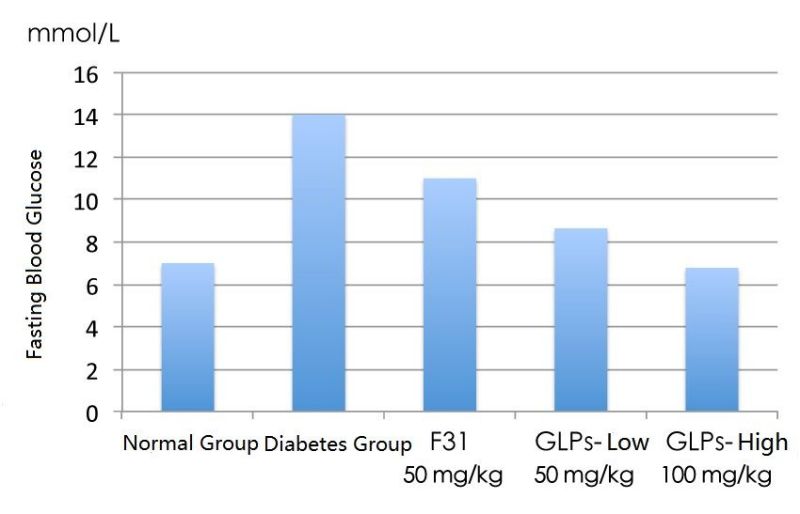
Figure 4 The effect of different kinds of Ganoderma lucidum polysaccharides on fasting blood glucose levels
[Description] After mice with type 2 diabetes (fasting blood glucose value 12-13 mmol/L) received daily intraperitoneal injection of Ganoderma lucidum polysaccharides F31 (50 mg/kg), Ganoderma lucidum crude polysaccharides GLPs (50 mg/kg or 100 mg/kg) for 7 consecutive days, their blood glucose levels were compared with those of normal mice and those of untreated diabetic mice. (Drawn by/Wu Tingyao, data source/Arch Pharm Res. 2012; 35(10):1793-801.J Ethnopharmacol. 2017; 196:47-57.)
Sources
1. Xiao C, et al. Antidiabetic activity of Ganoderma lucidum polysaccharides F31 down-regulated hepatic glucose regulatory enzymes in diabetic mice. J Ethnopharmacol. 2017 Jan 20;196:47-57.
2. Xiao C, et al. Hypoglycemic effects of Ganoderma lucidum polysaccharides in type 2 diabetic mice. Arch Pharm Res. 2012 Oct;35(10):1793-801.
END
About the author/ Ms. Wu Tingyao
Wu Tingyao has been reporting on first-hand Ganoderma information since 1999. She is the author of Healing with Ganoderma (published in The People’s Medical Publishing House in April 2017).
★ This article is published under the exclusive authorization of the author.
★ The above works cannot be reproduced, excerpted or used in other ways without the authorization of the author.
★ For violations of the above statement, the author will pursue relevant legal responsibilities.
★ The original text of this article was written in Chinese by Wu Tingyao and translated into English by Alfred Liu. If there is any discrepancy between the translation (English) and the original (Chinese), the original Chinese shall prevail. If readers have any questions, please contact the original author, Ms. Wu Tingyao.



